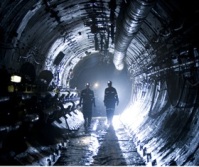Cameco announced that workers had re-entered the main working level of the Cigar Lake uranium mine in Saskatchewan, Canada, after it completed dewatering and securing the partially-flooded mine.
 |
| Workers underground at Cigar Lake, prior to its flooding in 2006 (Image: Cameco) |
Unfortunately one of the doors did not seal properly, allowing water to enter the processing area while worker attempts to fully seal the door were unsuccessful. Furthermore, the rate of water ingress far exceeded the speed water could be pumped out. Finally, Cameco managers decided there was no option but to allow the water to overtake the mine. All staff were evacuated with no injuries and there was no impact on the environment.
Cameco began a five-phase remediation programme in early 2007 to remove the water, originally expecting to complete dewatering No.1 shaft in the second half of 2008. By August that year, the shaft had been pumped down to 430 meters below the surface when an increase in water flow, to 600 cubic meters per hour, was reported. Such an inflow rate was "beyond the range that can be managed while sustaining work in the shaft," the company said. It therefore decided to suspend the remediation work.
By late October 2009, Cameco reported that the inflow of water at the 420-meter level that led to the suspension of dewatering activities had "been remediated by remotely placing an inflatable seal between the shaft and the source of the inflow and subsequently backfilling and sealing the entire development behind the seal with concrete and grout." It added that "the 420 level is not part of future mine plans."
At that time, the company resumed pumping out water from Cigar Lake and said that it expected "to take 6-12 months to dewater and secure the mine depending on what conditions are found in the shaft and the underground workings." Cameco also said that it would issue an estimated production start-up date after the water has been pumped out of the mine and the condition of the underground development has been assessed.
The workings at the 420-meter level, where the last inflow occurred, have been inspected and secured, Cameco said. Crews re-entered the main working level of the mine, 480 meters below the surface, on 10 February. Following dewatering of the mine, the main shaft has been refurbished, including the installation of the ladderway, replacement of electrical and mechanical components, and extension of the in-shaft pumping system. Work to inspect, assess and secure the underground development has begun, the company said. It added that following this work, the underground mine systems and infrastructure would be restored in preparation for the resumption of construction activities.
Jerry Grandey, Cameco's president and CEO, said: "Resuming work underground is a key milestone for the Cigar Lake project." He added, "We have incorporated the knowledge gained in the Athabasca Basin to systematically and diligently manage this project as we move toward our goal of safe, reliable production."
Cameco said that it expects to complete work to secure the underground development before October 2010 "depending upon the condition of the mine."
Cigar Lake is one of the world's most promising uranium deposits, with estimated reserves of 226.3 million pounds of U3O8 at grades as high as 20.7%. Led by Cameco, holding 50% of the project, a consortium of Areva Resources Canada (37%), Idemitsu Canada Resources (8%) and Tepco Resources (5%) has been developing the deposit. Originally, the mine was expected to begin operating in early 2008.
In December, the partners in the McClean Lake uranium mill project, 70 kilometres northeast of Cigar Lake, said it would be put on stand-by in mid-2010. The mill is operated and 70% owned by Areva Resources Canada, with Denison Mines holding 22.5% and OURD Canada holding the remaining 7.5%. The partners have said that the mill will continue to operate until July, processing stockpiled ore. The main future feed for the mill is to be from the high-grade Cigar Lake project. Areva said, "The mill re-start date will depend on market conditions and the Cigar Lake mine schedule."
Researched and written
by World Nuclear News




_47120.jpg)
_23621.jpg)

_63865.jpg)





